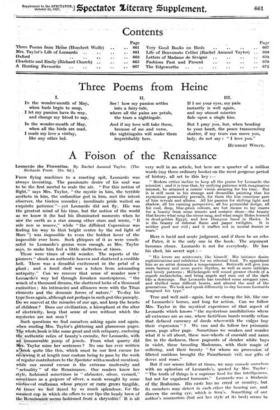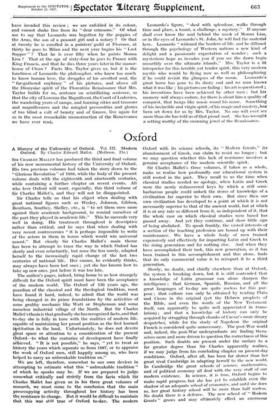Foison of the Renaissance
Leonardo the Florentine. By Rachel Armand Taylor. (The . Richards Press. 31s. 6d.) l'itok flying machines to a roasting spit, Leonardo was always inventing. The passionate desire of his soul was to be the first mortal to scale the air. "For this notion Of flight," says Mrs. Taylor, "the mystic in him, the terrible aesthete in him, the unfamiliar god in him, met the intent obsetver, the tireless recorder, inordinate pride waited on exquisite patience "—yet Leonardo did not fly. His was the greatest mind of his time, but the notion of the world as we know it (he had his illuminated moments when he is4w. the earth as a star among other stars and wrote, "II sble non se muove," while "the diffident Copernicus was finding his way to that bright eentie by the red light of Mars ") was impossible to even- the boldest lover of the impossible ever born. Such glimpses of it as were vouch- safed to Leonardo's genius were enough, as Mrs. Taylor says, to make him feel a little shelterless at times.
Those were times of wild wonder. The reports of the pioneers "shook an authentic heaven and shattered a credible hell. There was a dreadful excitement in the petal of a plant ; and a fossil shell was a token from astounding antiquity." Can we recover that sense of wonder now ? Leordo'S way led through forsaken masterpieces, "the wrack of a thousand dreams, the shattered locks of a thousand curiosities, his intimacies and alliances Were with the Titan elements 'and the demonic forces of nature." To-day his type lives again, although not perhaps in such god-like panoply. Do we marvel at the miracles of our age, and keep the hearts of children.? Does our civilization, a hierophant at the altar of electricity, keep that sense of awe without which the mysteries are not seen ?
Such questions we find ourselves asking again and again, when reading -Mrs. Taylor's glittering and glamorous pages. Tl wholehook is like some great and rich reliquary, enclosing tie' authentic relics of beauty's eremite, Ser Leonardo, with an innumerable Oniiip of jewels. From what quarry did . Taylor mine her sentences ? No one has ever written a (Mk quite like this, which must be our first excuse for rtiViewing it at length (our custom being to pass by the work of regular contributors to the Spectator with a modest mention), while our second excuse is the extreme modernity and "actuality" of the Renaissance. Our readers know her style, fashioned sometimes in "alabaster; silver, vermeil," sometimes as a guipure of silver, a mesh wrought by some rried' ineval craftsman .whose prayer or curse grows tangible. At times - we -feel lazed' by so intich Splendour, for the meatiest cup in which she offers to our lips the heady brew of the Itenaissarseems fashioned front a clucks-bile:6 ! rt all
• . .
very well in an article, but here are. a quarter of a million Words (say three ordinary books) on the most gorgeous period of history, all set to this key :— -
" Modern critics incline to keep all the praise for Leonardb the scientist ; and it is true that, by unifying patience with imaginative interest, he attained a cosmic vision amazing for his time. But it is still - most in his strange and dreamlike painting that his mysterious personality prevails, for there the leas conscious part of him reveals and allures. . All his passion for shifting light and shadow,- all his cunning perspective, all his pyramidal design,. all his cool, deep, blue-green colours, are but means to lay snares for a beauty from some remote and ecstatic shore—the beauty that knows what song the sirens sang, and what magic Helen learned in dead-golden Egypt, and how Dionysos fared. in Hades. It is the beauty of sidereal flame and jasper twilights. It is neither good -nor evil ; and it traffics not in mortal desires' or tears."
• Here is lucid and acute judgment, and if there be an echo of Pater, it is the only one in the book. The argument becomes. closer. Leonardo is -not for everybody. He has his elect, his secret sept " His lovers are aristocrats, like himself. His initiates desire sophistications and subtleties for an ethereal food. To apprehend him as an artist demands a temperament. Botticelli will give you more fantasy and more poetic rhythm, as well as . more intricate and lovely patterns ;• Michelangelo will sound greater chords of a superb melancholia, and bring angels and men out of the dark like a demiurge. But Leonardo has troubled some arrogant -,0YteS• and thrilled some difficult hearts, and altered the seed of the generations. 'We look and speak differently to-day because Leonardo imagined his type."
True and well said—again, but we champ the bit, like One of Leonardo's horses, and long for action. Can we follow Mrs. Taylor in the mystical experience of that aspect of Leonardo which knows "the mysterious annihilations where all extremes are as one, where fastidious hands wearily refuse that defaced currency of deeds wherewith the vulgar buy their expression " ? We can and do follow her prismatic prose, page after page. Sometimes we weaken and wonder what it is all about, these rose-whorls of emerald and azUre fire in the darkness, these pageants of slender white boys in violet, these brooding Madonnas, with their magic -of suffering, and their beauty "for whom no procession 'of filleted maidens brought the Panathenaic Veil, nor gifts of doves and roses."
But if our senses falter at times, we may console ourselves with an aphorism of Leonardo's, quoted by Mrs. Taylor : "The truth of things is a supreme food for fine intelligences,
but not for vagabond humours." Leonardo was a Brahmin
Of the' Brahmins. His caste has no creed or country, but its members may detect in each other the hearing ear, and discern the seeing eye, which is Siva's. .Something of our author's initrineriam (bat nOt her style at its best) seems to
have invaded this review ; we are enfolded in its colour, and cannot shake free from its "dear crimsons." Of what use to say that Leonardo was begotten by the poppies of the Arno, the son of a peasant girl and a notary ? Or that at twenty he is enrolled in a painters' guild at Florence, at thirty he goes to Milan and the next year begins his "Last Supper " ? That he is over fifty when he paints Monne Lisa ? That at the age of sixty-four he goes to France with King Francis, and that he dies three years later in the manor- house of Cloux ? Facts Mrs. Taylor gives us, but it is the loneliness of Leonardo the philosopher, who knew too much to know human love, the struggles of his occulted soul, the "far-gathered euphrasy " of his pictures, and above all the Dionysiac spirit of the Florentine Renaissance that Mrs. Taylor builds for us, sentence on scintillating sentence, so that the city of Lorenzo the Magnificent, the Court of Ludovico, the wandering years of camps, and burning cities and treasons and magnificences and the mingled perversities and glories of too blind a cult of beauty and of Greece, live again for us in the most remarkable reconstruction of the Renaissance we have ever read. Leonardo's _ figure, "shod with splendour, walks through time and place, a taunt, a challenge, a mystery." If anyone shall ever know the soul behind the mask of Monna Lisa, or in the eyes of Leonardo's St. John, he will find the material here. Leonardo "widened the borders of life, and he diffused through the psychology of Western nations a new kind of delight and a passionate expectation of wonder ; such a mysterious hope as invades you if you see the dawn begin unearthly over the ultimate islands." Mrs. Taylor is a fit interpreter for this terrible yet tender spirit, this very modern mystic who would be flying now as well as philosophizing if he could revisit the glimpses of the moon. Leonardo's great horse has gone to its dusty end and no man knows what it was like ; his pictures are fading ; his art is questioned ; his inventions have been achieved by other men ; but his memory will always endure, for there is about him a quality of conquest, that hangs like music round his name. Something of his invincible and virgin spirit, of his magic and mastery, has been set down for us by Mrs. Taylor. No one will ever see more than she has told us of that proud soul. She has wrought a setting worthy of the crowning jewel of the Renaissance.



























































 Previous page
Previous page